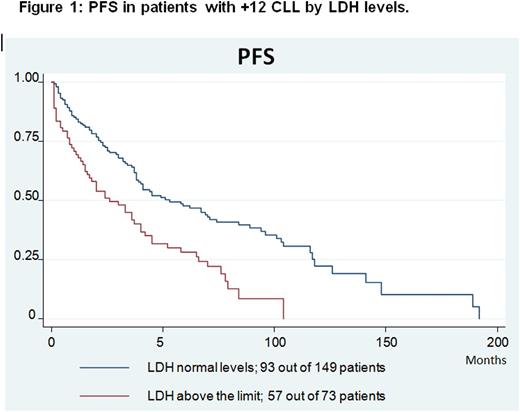Abstract
Introduction. Patients with CLL and FISH positive for trisomy 12 (+12) have unique clinical and biological features. We, therefore, performed an analysis of the association between demographic, clinical, laboratoristic and biological features and outcomes in treatment-naive patients with +12 CLL.
Methods. This study included 312 treatment-naive patients with +12 CLL from 9 centers. These patients, diagnosed between January 2000 and July 2016, were compared to a control group of 580 treatment-naive patients with FISH negative CLL, matched by age and gender and followed in the same centers. An additional cohort of 250 patients with +12 CLL followed at a single US institution was used as external validation.
Results. Patients' baseline characteristics are shown in Table 1. As compared to patients with negative FISH, patients with +12 had a significant higher prevalence of elevated LDH (p<0.001), elevated β-2-microglobulin (p<0.001), ZAP70 positivity (p<0.001), CD38 positivity (p<0.001), CD49d positivity (p<0.001) and unmutated IGHV (p<0.001). Among patients with +12, 206 (66%) progressed and 193 (62%) required treatment, 76 (24%) patients died and 28 (9%) deaths were attributed to CLL. Among patients with negative FISH, 260 (45%) progressed and 213 (37%) were treated, 97 (17%) patients died and 46 (8%) deaths were attributed to CLL progression. Patients with +12 CLL showed shorter survival in terms of progression free survival (PFS: 69 months vs 110 months, p<0.001), treatment free survival (TFS: 77 months vs 125 months, p<0.001) and overall survival (OS: 147 months vs 165 months, p=0.005). Clinico-biological factors associated with shorter PFS were found performing univariate analysis among +12 CLL patients. These data were confirmed also when using the external validation group of +12 patients for ZAP70 positivity (p=0.03), CD38 positivity (p=0.004), β-2-microglobulin levels (p<0.001) and Rai stage (p<0.001). Furthermore we divided our cohort of patients with +12 CLL according to LDH levels available at diagnosis: 73 patients showed levels above the normal limit many times and 149 patients had normal levels. High LDH levels resulted associated with a shorter PFS (37 months vs 73 months, p<0.001; Figure 1), shorter TFS (41 months vs 84 months, p<0.001), shorter OS (115 months vs 155 months, p=0.002) and shorter CLL-specific survival (134 months vs 179 months, p<0.001). This association was maintained on multivariable analyses both for PFS (hazard ratio [HR] 1.95, 95% confidence interval [CI] 1.3 to 3.0; p=0.002) and TFS (HR 1.81, 95% CI 1.1-3.0; p=0.025). LDH levels were also significantly correlated to OS (p<0.05) evaluating the events attributed to CLL.
Conclusions. In this large cohort analysis of 321 patients with +12 CLL, we were able to confirm that LDH levels above normal are common in this group and we observed that LDH levels independently predict a shorter PFS, TFS and CLL-specific survival in this population. LDH levels at diagnosis could allow to suspect trisomy 12 in CLL patients and predict different prognosis.
Coscia:Karyopharm: Research Funding; ROCHE: Honoraria, Other: Advisory board; Gilead: Honoraria; Mundipharma: Honoraria; Janssen: Honoraria. D'Arena:Janssen-Cilag: Honoraria. Reda:Gilead: Research Funding; Roche: Membership on an entity's Board of Directors or advisory committees.
Author notes
Asterisk with author names denotes non-ASH members.



This feature is available to Subscribers Only
Sign In or Create an Account Close Modal